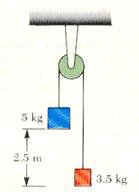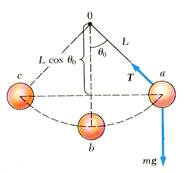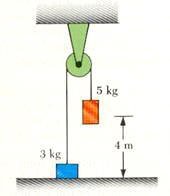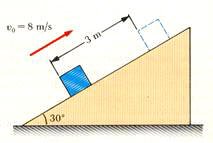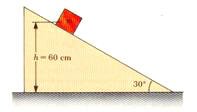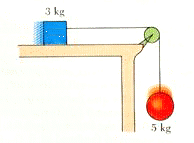محاضرة 18 فيزياء عامة (1) ميكانيكا نيوتن .. تمارين محلولة على طاقة الوضع والحفاظ على الطاقة
Potential energy and conservation energy
| (1) A single conservative force acting on a particle varies as F = (-Ax + Bx2)i N, where A and B are constants and xis in m. (a) Calculate the potential energy associated with this force, taking U = 0 at x = 0. (b) Find the change in potential energy and change in kinetic energy as the particle moves from x = 2 m to x = 3 m. |
| (1) استخدم المعادلة رقم 5.1 صفحة 135 في الكتاب المقرر.(2) استخدم المعادلة رقم 5.2 صفحة 135 في الكتاب المقرر. |
| (2) A 4-kg particle moves along the x-axis under the influence of a single conservative force. If the work done on the particle is 80J as the particle moves from x=2m tox=5m, find (a) the change in the particle’s kinetic energy, (b) the change in its potential energy, and (c) its speed at x=5m if it starts at rest at x=2m. |
| (1) التغير في طاقة الحركة يساوي الشغل المبذول. W = 80J = DK(2) التغير في طاقة الوضع يساوي سالب الشغل W = – 80J = DU (3) استخدم القانون التالي لإيجاد السرعة النهائية مع العلم بان السعة الابتدائية = 0 W = DK = Kf – Ki W = 1/2 mvf2 – 1/2 m vi2 = 1/2 m (vf2 – vi2)
|
| (3) A single conservative force Fx = (2x + 4) N acts on a 5-kg particle, where x is in m. As the particle moves along the x axis from x = 1 m to x = 5 m, calculate (a) the work done by this force, (b) the change in the potential energy of the particle, and (c) its kinetic energy at x = 5 m if its speed at x =1m is 3 m/s. |
| (1) كامل دالة القوة بالنسبة للازاحة وحدود التكامل من 1 إلى 5(2) التغير في طاقة الوضع تساوي سالب دالة الشغل التي نتجت من (1)
(3) التغير في طاقة الحركة تساوي دالة الشغل |
| (4) Use conservation of energy to determine the final speed of a mass of 5.0kg attached to a light cord over a massless, frictionless pulley and attached to another mass of 3.5 kg when the 5.0 kg mass has fallen (starting from rest) a distance of 2.5 m as shown in Figure 5.9
|
| من قانون الحفاظ على الطاقة الميكانيكيةEf = Ei
Ei = Ki + Ui = 0 + Mgh Ef = Kf + Uf = 1/2 mv2 + 1/2 Mv2 + mgh Mgh = 1/2 mv2 + 1/2 Mv2 + mgh من هذه المعادلة يمكن إيجاد السرعة المطلوبة |
| (5) A 5-kg mass is attached to a light string of length 2m to form a pendulum as shown in Figure 5.10. The mass is given an initial speed of 4m/s at its lowest position. When the string makes an angle of 37o with the vertical, find (a) the change in the potential energy of the mass, (b) the speed of the mass, and (c) the tension in the string. (d) What is the maximum height reached by the mass above its lowest position?
|
| انظر المثال رقم 5.5 صفحة 140 في الكتاب المقرر |
| (6) A 0.5-kg ball is thrown vertically upward with an initial speed of 16 m/s. Assuming its initial potential energy is zero, find its kinetic energy, potential energy, and total mechanical energy (a) at its initial position, (b) when its height is 5m, and (c) when it reaches the top of its flight. (d) Find its maximum height using the law of conservation of energy. | ||||||||||||||||||||
| m = 0.5 kg vi = 16 m/s Ui = 0
|
| (7) Two masses are connected by a light string passing over a light frictionless pulley as shown in Figure 5.11. The 5-kg mass is released from rest. Using the law of conservation of energy, (a) determine the velocity of the 3-kg mass just as the 5-kg mass hits the ground. (b) Find the maximum height to which the 3kg mass will rise.
|
| من قانون الحفاظ على الطاقة الميكانيكيةEf = Ei
Ef = Kf + Uf = 1/2 mv2 + 1/2 Mv2 + mgh Ei = Ki + Ui = 0 + Mgh 1/2 mv2 + 1/2 Mv2 + mgh = Mgh لإيجاد أقصى ارتفاع للجسم نعتبر أن الجسم عندما يصل إلى مسافة 4م من سطح الأرض الحالة الإبتدائية وعندها نعتبر أن طاقة الوضع تساوي صفر وعند أقصى ارتفاع تكون طاقة الحركة تساوي صفر Ef = Ei 0 + 1/2 mv2 = mgh + 0 حيث أن اقصى ارتفاع للكتلة الصغيرة عن سطح الأرض يساوي 4+h |
| (8) A 5-kg block is set into motion up an inclined plane as in Figure 5.12 with an initial speed of 8 m/s. The block comes to rest after travelling 3 m along the plane, as shown in the diagram. The plane is inclined at an angle of 30′ to the horizontal. (a) Determine the change in kinetic energy. (b) Determine the change in potential energy. (c) Determine the frictional force on the block (assumed to be constant). (d) What is the coefficient of kinetic friction?
|
| من معطيات السؤال فإنKi = 1/2 m vi2 & Ui =0
Kf = 0 & Uf = mgh (a) The change in kinetic energy = Kf – Ki (b) The change in potential energy = Uf – Ui (c) The force of friction – f s = (Kf+Uf) – (Ki + Ui) (d) the coefficient of kinetic friction uk f = uk mg cos30 |
| (9) A block with a mass of 3 kg starts at a height h = 60 cm on a plane with an inclination angle of 30′, as shown in Figure 5.13. Upon reaching the bottom of the ramp, the block slides along a horizontal surface. If the coefficient of friction on both surfaces is ,Uk = 0.20, how far will the block slide on the horizontal surface before coming to rest? [Hint: Divide the path into two straight-line parts].
|
| Wnc = (Kf+Uf) – (Ki + Ui)
-f s = (1/2 m v2 + 0) – (0 + mgh) من هذه المعادلة يمكن إيجاد السرعة عند نهاية المنحدر. لإيجاد المسافة التي سيقطعها الجسم على السطح الأفقي قبل أن يتوقف نستخدم القانون التالي Wnc = (Kf+Uf) – (Ki + Ui) – f s = (1/2 m v2 + 0) – ( 0+0) –uk mg cos30 * s = 1/2 m v2 يمكن إيجاد s |
| (10) The coefficient of friction between the 3.0-kg object and the surface in Figure 5.14 is 0.40. What is the speed of the 5.0-kg mass when it has fallen a vertical distance of 1.5 m?
|
| حيث أن الكتلة تتحرك على سطح خشن والاحتكاك غير مهمل نستخدم القانون العام للطاقة الميكانيكية الكلية.
Wnc = Ef – Ei Wnc = (Kf+Uf)-(Ki + Ui) – f s = – uk mg s = (1/2 m v2 +1/2 M v2 + mgy + 0) – (0 + 0 + mgy + Mgh) Note that s = h من هذه المعادلة يمكن إيجاد سرعة الجسم عندما يكون تحرك مسافة 1.5 م |
| (11) A mass of 2.5 kg is attached to a light spring with k = 65 N/m. The spring is stretched and allowed to oscillate freely on a frictionless horizontal surface, When the spring is stretched 10cm, the kinetic energy of the attached mass and the elastic potential energy are equal. What is the maximum speed of the mass? |
| حيث أن طاقة الحركة تساوي طاقة الوضع عندما يكون طول الزنبرك 10سم للجسم المتحرك على سطح عديم الاحتكاك وكذلك فإننا نعلم أن السرعة القصوى للجسم عندما يكون الزنبرك عند نقطة الاتزان أي عند x=0من قانون الحفاظ على الطاقة الميكانيكية
Ef = Ei نعتبر أن الحالة الابتدائية عند x=0 والحالة النهائية عند x= 10 2 (1/2 k x2)= 1/2 m vmax2 + 0 تم الضرب في 2 لأنه عند x=10cm فإن طاقة الحركة تساوي طاقة الوضع |


